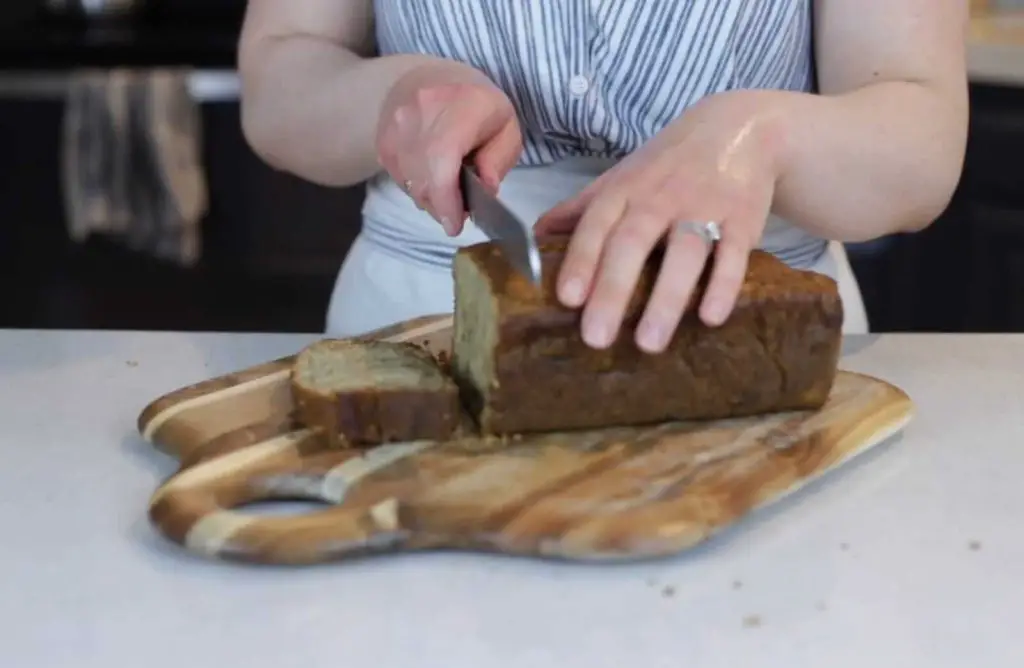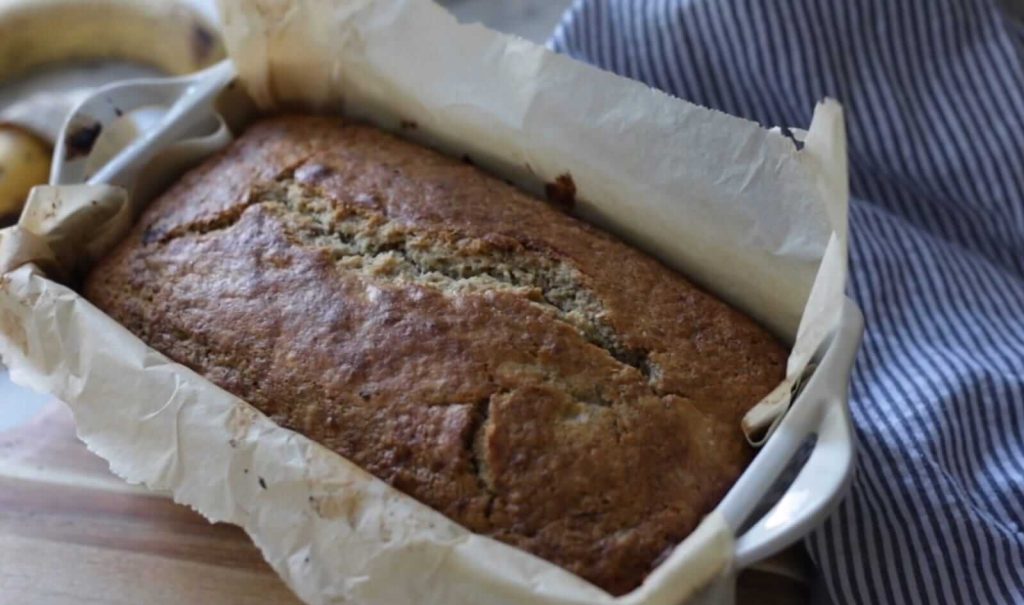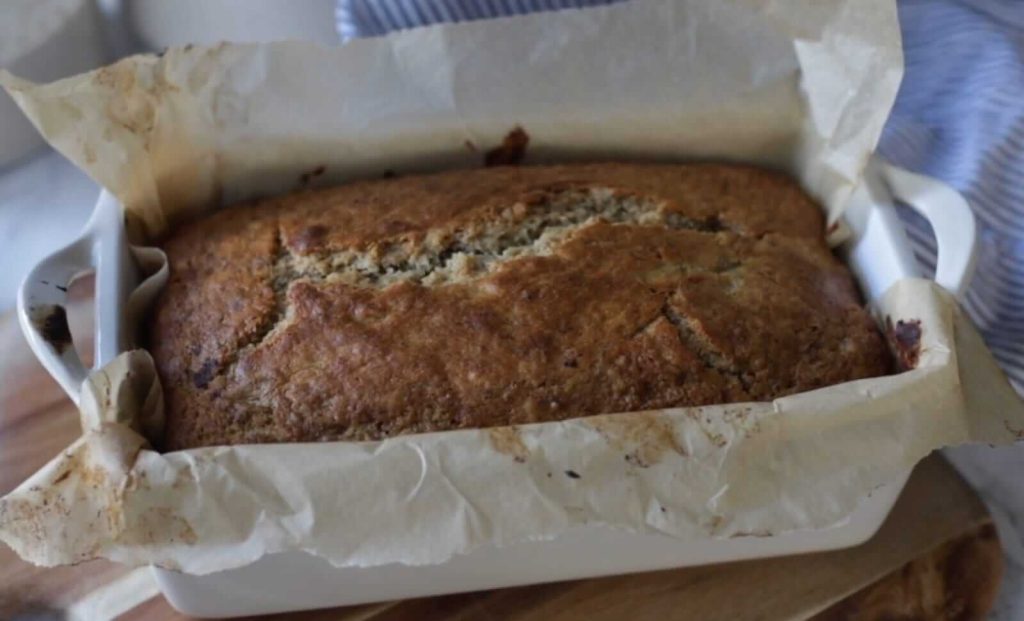Sourdough Banana Bread is a delightful twist on the classic banana bread recipe. It combines the natural sweetness of ripe bananas with the tangy undertones of sourdough starter, resulting in a moist, flavorful loaf that’s both sweet and slightly sour. The use of sourdough starter not only imparts a unique flavor but also gives the bread a more robust texture compared to traditional banana bread.
The fermentation process of the sourdough starter also offers potential health benefits, such as improved digestibility and increased availability of nutrients. Moreover, the natural yeast in the starter can act as a leavening agent, giving the bread a nice rise without the need for commercial yeast.
The crust of the sourdough banana bread is golden brown and slightly crispy, while the inside remains soft and tender. It’s perfect for Breakfast and Brunch, a snack, or dessert, and can be enjoyed plain, toasted, or with a spread of butter or jam. The combination of bananas and sourdough creates a harmonious blend of flavors that is sure to please both banana bread enthusiasts and sourdough lovers alike.

Sourdough Banana Bread: A Delightful Twist
Banana bread, a classic comfort food, has been a staple in many households for generations. Its moist texture, sweet flavor, and the aroma that fills the kitchen while it bakes make it a favorite. But have you ever considered giving this beloved treat a delightful twist by incorporating sourdough? Let’s delve into the magic of combining sourdough and banana.
What Makes Sourdough Special?
- Natural Fermentation: At the heart of sourdough is its natural fermentation process. Unlike commercial breads that use store-bought yeast, sourdough relies on wild yeast and lactic acid bacteria. This not only gives sourdough its distinct tangy flavor but also makes it easier to digest.
- Nutritional Benefits: The fermentation process breaks down some of the phytic acid found in flour. This means that the minerals in sourdough bread are more bioavailable than in regular bread. Additionally, the lactic acid bacteria present can improve gut health.
- Unique Texture and Flavor: Sourdough has a chewy crust and a soft, airy interior. Its flavor profile is complex, ranging from mildly tangy to robustly sour, depending on the fermentation time and the specific strains of wild yeast and bacteria present.
- Longer Shelf Life: Due to its acidity, sourdough bread naturally resists mold, giving it a longer shelf life than many other breads.
The Magic of Combining Sourdough and Banana
- Enhanced Flavor Profile: The tanginess of the sourdough beautifully complements the natural sweetness of ripe bananas. This combination creates a harmonious balance of flavors, making each bite a delightful experience.
- Improved Texture: While traditional banana bread is known for its moistness, adding sourdough starter can introduce a slightly chewier texture, giving the bread a more substantial feel.
- Natural Sweetness: Since ripe bananas are naturally sweet, there’s often no need to add as much sugar when making sourdough banana bread. The natural sugars from the bananas, combined with the tang of the sourdough, create a perfectly balanced taste.
- A Healthier Twist: By incorporating sourdough into your banana bread, you’re not only enhancing its flavor and texture but also boosting its nutritional profile. The fermentation process can make some nutrients more accessible and can also introduce beneficial bacteria.
sourdough banana bread is more than just a fusion of two beloved foods. It’s a delightful dance of flavors and textures, a testament to the wonders of culinary experimentation. Whether you’re a seasoned baker or a curious novice, this twist on the classic banana bread is sure to captivate your taste buds.

Ingredients for the Perfect Sourdough Banana Bread
Perfect Sourdough Banana Bread
Essential Ingredients:
- Sourdough starter (unfed/discard): 1 cup (240g)
- Ripe bananas: 3-4 (about 1 1/2 cups mashed)
- All-purpose flour: 2 cups (240g)
- Granulated sugar: 3/4 cup (150g)
- Unsalted butter (melted): 1/2 cup (115g)
- Eggs: 2 large
- Vanilla extract: 1 teaspoon
- Baking soda: 1 teaspoon
- Salt: 1/2 teaspoon
Optional Add-ins for Extra Flavor:
- Chopped nuts (e.g., walnuts or pecans): 1/2 cup
- Chocolate chips: 1/2 cup
- Dried fruits (e.g., raisins, cranberries): 1/2 cup
- Shredded coconut: 1/3 cup
- Cinnamon: 1 teaspoon
- Nutmeg: 1/4 teaspoon
- Espresso powder: 1/2 teaspoon (for a deeper flavor)
- Orange or lemon zest: 1 tablespoon
- Dark rum or bourbon: 1-2 tablespoons
- Brown sugar (replace some or all of the granulated sugar for a deeper flavor)
Instructions:
- Preheat your oven to 350°F (175°C) and grease a 9×5-inch loaf pan.
- In a large bowl, mash the ripe bananas until smooth.
- Add the melted butter, sugar, eggs, vanilla extract, and sourdough starter to the mashed bananas and mix until well combined.
- In a separate bowl, whisk together the flour, baking soda, and salt. If you’re using cinnamon and/or nutmeg, whisk them in as well.
- Gradually add the dry ingredients to the wet ingredients, mixing just until combined.
- Fold in any optional add-ins you’re using, like nuts, chocolate chips, dried fruits, etc.
- Pour the batter into the prepared loaf pan and smooth the top.
- Bake for 60-70 minutes, or until a toothpick inserted into the center comes out clean.
- Allow the bread to cool in the pan for about 10 minutes, then transfer to a wire rack to cool completely.

Step-by-Step Guide to Making Sourdough Banana Bread
Sourdough Banana Bread: Step-by-Step Guide
1. Preparing the Sourdough Starter:
Ingredients:
- 100g all-purpose flour
- 100g water (room temperature)
- 1 tbsp active sourdough starter (if you don’t have one, you can either buy it or make one from scratch, which takes about a week)
Procedure:
- In a clean jar or container, mix the flour and water until there are no dry spots.
- Add the active sourdough starter and mix well.
- Cover the container loosely with a lid or cloth, allowing it to breathe.
- Let it sit at room temperature for 8-12 hours or until it has doubled in size and shows bubbles on the surface. This is now your “levain” or active starter for the banana bread.
2. Mixing and Baking the Bread:
Ingredients:
- 1 cup active sourdough starter (from the above step)
- 3 ripe bananas, mashed
- 1/4 cup melted butter or coconut oil
- 2 eggs
- 1 tsp vanilla extract
- 3/4 cup sugar (can adjust based on preference)
- 2 cups all-purpose flour
- 1 tsp baking soda
- 1/2 tsp salt
- 1/2 tsp cinnamon (optional)
- 1/2 cup chopped nuts or chocolate chips (optional)
Procedure:
- Preheat the Oven: Preheat your oven to 350°F (175°C). Grease a loaf pan or line it with parchment paper.
- Mix Wet Ingredients: In a large mixing bowl, combine the active sourdough starter, mashed bananas, melted butter or coconut oil, eggs, vanilla extract, and sugar. Mix until well combined.
- Add Dry Ingredients: In a separate bowl, whisk together the all-purpose flour, baking soda, salt, and cinnamon. Gradually add this dry mixture to the wet ingredients, stirring until just combined. If you’re adding nuts or chocolate chips, fold them in now.
- Pour and Bake: Pour the batter into the prepared loaf pan. Place it in the preheated oven and bake for 60-70 minutes, or until a toothpick inserted into the center comes out clean.
- Cool: Once baked, remove the bread from the oven and let it cool in the pan for about 10 minutes. Afterward, transfer it to a wire rack to cool completely.
- Serve: Slice the cooled sourdough banana bread and enjoy!
Note: The sourdough starter gives the banana bread a slightly tangy flavor, which contrasts beautifully with the sweetness of the bananas. The bread’s texture is also a bit more chewy and hearty compared to regular banana bread. Enjoy your homemade sourdough banana bread with a cup of tea or coffee!
Benefits of Using Sourdough in Baking
Sourdough is a traditional method of bread baking that uses a fermented mixture of water and flour, known as a “starter,” to leaven the bread. This method has been used for thousands of years and offers several benefits, both nutritionally and in terms of flavor.
Benefits of Using Sourdough in Baking:
- Nutritional Advantages:a. Improved Digestibility: The fermentation process breaks down some of the gluten in the flour, which can make sourdough bread easier to digest for some people.b. Lower Glycemic Index: Sourdough fermentation can reduce the glycemic index of bread, which means it can cause a slower rise in blood sugar levels when consumed.c. Higher Nutrient Content: The lactic acid bacteria present in sourdough can help increase the bioavailability of minerals like calcium, magnesium, and zinc. This means that these minerals are more easily absorbed by the body.d. Presence of Probiotics: While the baking process kills the live bacteria in the sourdough, the fermentation process can still produce beneficial compounds and modify the pH and composition of the bread, which can have positive effects on gut health.e. Reduction of Phytic Acid: Sourdough fermentation reduces the phytic acid content in bread. Phytic acid can inhibit the absorption of certain minerals in the intestines, so its reduction can further enhance the nutritional benefits of the bread.f. Natural Preservative: The acidic nature of sourdough acts as a natural preservative, which can extend the shelf life of the bread and reduce the need for artificial preservatives.
- Unique Flavor Profile:a. Complex Taste: Sourdough bread has a distinctive tangy flavor, which comes from the lactic acid produced by the bacteria during fermentation. This tanginess can add depth and complexity to the taste of the bread.b. Better Texture: The fermentation process can give sourdough bread a chewy texture and a thick, crunchy crust, which many people find appealing.c. Versatility: While sourdough is often associated with bread, the starter can be used in a variety of baked goods, including pancakes, waffles, muffins, and even cakes. Each of these can benefit from the unique flavor and texture that sourdough imparts.d. Aroma: The fermentation process gives sourdough baked goods a rich, aromatic scent that is unmistakably different from breads made with commercial yeast.
sourdough not only offers a unique and delightful flavor profile but also presents several nutritional advantages over conventionally leavened baked goods. Whether you’re a baking enthusiast or someone who simply enjoys good food, sourdough is a wonderful addition to the world of baking.
Common Mistakes and How to Avoid Them: Sourdough Bread Edition
Sourdough bread is a delightful and ancient form of bread-making that relies on natural fermentation. However, it can be a bit tricky for beginners. Here are two common mistakes and how to avoid them:
- Overlooking the Sourdough StarterMistake: Many beginners either neglect their sourdough starter or don’t give it the attention it needs. A weak or inactive starter can result in bread that doesn’t rise well or has an off flavor.How to Avoid:
- Regular Feeding: Feed your starter regularly, typically once a day if it’s at room temperature or once a week if it’s refrigerated.
- Use the Right Proportions: When feeding, use equal parts (by weight) of water and flour. This 1:1 ratio keeps the starter healthy and active.
- Check for Activity: Before using your starter in a recipe, ensure it’s bubbly and has a pleasant tangy aroma. If it has a layer of liquid on top (often referred to as “hooch”), it’s a sign that it’s hungry and needs feeding.
- Temperature Matters: Starters are most active at warmer room temperatures (around 70°F or 21°C). If your home is cooler, consider finding a warmer spot for your starter or using warmer water during feedings.
- Not Giving the Bread Enough Time Mistake: Impatience can be a baker’s downfall. Sourdough, in particular, requires longer fermentation times than breads made with commercial yeast. Rushing this process can result in dense loaves without the characteristic sourdough flavor.How to Avoid:
- Understand Bulk Fermentation: After mixing the dough, it needs to undergo bulk fermentation. This can take anywhere from 4 to 12 hours (or even longer) depending on the temperature and the activity of your starter. The dough should roughly double in size and be full of air bubbles.
- Shape and Second Rise: Once bulk fermentation is complete, shape your dough and let it rise a second time in a banneton or a similar container. This can take another 2 to 4 hours.
- Use the Fridge: If you need to slow down the fermentation process (or if you want to develop more flavor), you can place the dough in the refrigerator for an extended fermentation, often referred to as a “cold retard.” This can be done during bulk fermentation or after shaping.
- Perform the Poke Test: To check if your bread has risen enough, gently poke it with a floured finger. If the indentation fills back slowly and leaves a small dimple, it’s ready to bake. If it springs back immediately, it needs more time. If the indentation stays and doesn’t bounce back, it might be over-proofed.
Remember, sourdough bread-making is as much an art as it is a science. It requires patience, observation, and a willingness to learn from mistakes. With time and practice, you’ll be able to produce beautiful and flavorful loaves.
FAQ For Sourdough Banana Bread
Sourdough banana bread uses sourdough starter, which imparts a tangy flavor that complements the sweetness of the bananas. The natural fermentation from the starter can also give the bread a unique texture.
Yes, overripe bananas with black or brown spots are ideal. They are sweeter, mash easily, and provide a stronger banana flavor.
While many recipes use sourdough discard, an active starter can also be used. It might give the bread a more pronounced sourdough taste and cause it to rise more due to the active yeast.
Baking times can vary based on the specific recipe and oven, but generally, it’s baked for 50-60 minutes at 350°F (175°C). Always do the toothpick test to ensure doneness.
Once cooled, store it in an airtight container at room temperature for up to 3 days. For longer storage, refrigerate or freeze.
Recipe For Sourdough Banana Bread
Sourdough Banana Bread is a delightful fusion of the tangy undertones of traditional sourdough and the sweet, moist richness of classic banana bread. This bread boasts a tender crumb that’s perfectly balanced between fluffy and dense, with the unmistakable aroma of ripe bananas. The inclusion of sourdough starter not only imparts a subtle tartness but also adds depth and complexity to the flavor profile.
Equipment
9×5 inch loaf pan
Mixing bowls
Fork or potato masher (for bananas)
Whisk or spatula
Measuring cups and spoons
Oven
Ingredients
1 cup (240g) sourdough starter (discard or active)
3 ripe bananas, mashed
1/4 cup (60ml) melted butter or coconut oil
1/4 cup (60ml) milk or almond milk
3/4 cup (150g) granulated sugar
1 large egg
1 teaspoon vanilla extract
Use 1 1/2 cups (190g) all-purpose flour
1 teaspoon baking soda
Use 1/2 teaspoon salt
1/2 teaspoon ground cinnamon (optional)
Use 1/2 cup (60g) chopped nuts or chocolate chips (optional)
Instructions
Preparation: Preheat your oven to 350°F (175°C). Grease a 9×5-inch loaf pan or line it with parchment paper.
Mix Wet Ingredients: In a large mixing bowl, combine the mashed bananas, melted butter or coconut oil, milk, sugar, egg, and vanilla extract. Mix until everything is well combined.
Add Sourdough Starter: Stir in the sourdough starter and mix until fully incorporated.
Dry Ingredients: In a separate bowl, whisk together the all-purpose flour, baking soda, salt, and cinnamon (if using).
Combine: Gradually add the dry ingredients to the wet mixture, stirring just until combined. Be careful not to overmix. If you’re using nuts or chocolate chips, fold them in now.
Pour and Bake: Pour the batter into the prepared loaf pan. Place it in the preheated oven and bake for 60-70 minutes, or until a toothpick inserted into the center comes out clean or with just a few crumbs.
Cool: Once baked, remove the banana bread from the oven and let it cool in the pan for about 10 minutes. Afterward, transfer it to a wire rack to cool completely.
Serve: Slice the cooled banana bread and serve. It pairs wonderfully with a cup of coffee or tea!
Note
The sourdough starter can be active or discard. Using an active starter might give a slight rise to the bread, while discard will mainly impart flavor.
For a healthier version, you can reduce the sugar or replace it with alternatives like coconut sugar or maple syrup. Adjust to taste.
Feel free to add in other mix-ins like dried fruits or seeds for added texture and flavor
American Cuisine
Banana, Bread, Breakfast, Brunch, Dessert, Fermented, Sourdough


4 thoughts on “Sourdough Banana Bread Recipe: A Tangy & Sweet Delight!”